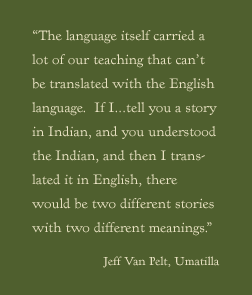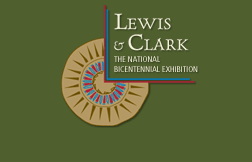

|
 |



Lesson Plan 1: Challenges of Interpretation
OBJECTIVES
Students will:
- define "culture" and "interpreter"
- learn a simple phrase in Indian sign language
- put a language chain in the correct order
MATERIALS
OPENING
Ask students the following questions:
- How do people communicate with each other? (Accept answers such as verbal, gestures, music, sign language, silence, etc.)
- What happens if you are visiting with someone and you do not speak his or her language? How do you communicate?
- What is a culture? Can you give examples of a culture?
- How do people communicate within a culture? (common verbal language)
- What would happen if you are visiting people and you do not speak the same language that they do? How do you communicate? Ask for examples.
Explorers Lewis and Clark and the members of their expedition party traveled from St. Louis to the Pacific Ocean and back. In preparing for their trip, they knew they would be encountering many different Indian cultures that were unfamiliar to them. How do you think they prepared? Create a list of student answers and keep it to refer to throughout the unit.
Explain that students will be using the Lewis and Clark expedition to study language and how it links to culture.
PROCEDURE
- Show students the map of Indian cultures along the Lewis and Clark trail. This map shows historic tribal territories at the time of Lewis and Clark. Ask students to count the approximate number of cultures through which the expedition traveled. It is important to note that they did not actually meet Indians from each culture. For the most part Lewis and Clark were traveling on rivers. Often Indian villages were not located by the river, or the tribe was somewhere else at the time Lewis and Clark passed through.
- Lewis and Clark knew the Indians they would encounter on their journey spoke many different languages and that communication would be a challenge. They hired several people to serve as interpreters. What is an interpreter?
(someone who translates a message so it can be understood by someone else)
- They hired different people as interpreters. One was George Drouillard, part-Shawnee Indian, who spoke Native sign language. They also hired Francois Labiche, who spoke French and several Indian languages, and Toussaint Charbonneau, who spoke French and Hidatsa. Charbonneau's wife was named Sacagawea. She spoke Hidatsa and Shoshone. Members of the expedition spoke many different languages, and even communication among the members could be challenging. If Lewis wanted to speak to Sacagawea, he needed two interpreters. It was important to know who spoke what language. Sometimes it took up to six people just to communicate a simple phrase.
- Provide students with access to the online Language Chain interactive. This activity features five people and challenges students to put those people in the correct order to send a message from Meriwether Lewis to Cameahwait, a Shoshone chief. Students will know what languages each person speaks. When they are correct, they will be able to hear what the message sounded like in each language.
If a computer is not available, select five students to be the speakers in the language chain. In the correct order, they are Meriwether Lewis (speaks English), Francois Labiche (speaks English and French and several Indian languages), Toussaint Charbonneau (speaks French and Hidatsa), Sacagawea (speaks Hidatsa and Shoshone), and Cameahwait (speaks Shoshone). Mix the five students up and ask the class to put them in the correct order that allows Lewis to communicate with Cameahwait.
- Although they do not speak different languages, the challenge of a communication chain can be demonstrated through the game "Whisper Down the Line." Begin with one student and whisper a sentence or two to him or her. Have each student pass the message to the next person in the chain with the final person reporting the message. Is the message accurate?
Ask students if they think the interpreters ever made mistakes.
Could everything Lewis and Clark and Cameahwait wanted to say be communicated? In other words, do all languages include the same words and ideas? (This concept will be the focus of Lesson 3.)
- So far the class has focused on verbal translation. As mentioned earlier, Lewis and Clark hired George Drouillard, a sign language interpreter.
Background Information from Lewis and Clark: Across the Divide:
"I now explained to them [the Shoshone Indians] the objects of our journey," Lewis wrote on August 14, 1805. "The means I had of communicating with these people was by way of Drewyer [George Drouillard ] who understood perfectly the common language of jesticulation or signs which seems to be universally understood by all the Nations we have yet seen." Lewis had probably brought his high opinion of the powers of sign language with him. Thomas Jefferson himself had transmitted the first systematic study of sign language, by William Dunbar, to the American Philosophical Society in 1801. In that paper, Dunbar made a claim that formed one of Lewis's axiomatic expectations: "Almost all the Indian nations living between the Mississippi, and the Western American ocean, understand and use the same language by signs, although their respective oral tongues are frequently unknown to each other." And yet a later comparison of the signs recorded by early explorers, who had observed their use among diverse tribes, showed almost no agreement on the signs for basic terms like chief, day, dead, fear, woman, and yes. The sign-language vocabulary was largely confined to concrete objects and practical verbs, not concepts like sovereignty or exploration. Even Lewis conceded, "This language is imperfect and liable to error." But perhaps hesitant to contradict scholarship with experience, he added that the errors were "much less so than would be expected." He noted, "The strong parts of the ideas are seldom mistaken." So whether George Drouillard's Shawnee sign language actually conveyed "the objects of our journey" to the Shoshone may be doubted. But whatever it did convey must have satisfied them. Lewis wrote: "The Indians entertained us with their dancing nearly all night. . . . I was several times awoke . . . by their yells but was too much fortiegued to be deprived of a tolerable sound night's repose."
- Show students the video footage of an actor portraying George Drouillard. Students should try to learn the three messages he is signing:
- Do you want to trade four buffalo robes?
- I own two guns and three knives to trade
- We come here as friends to you.
- Again, ask students if they think the interpreters ever made mistakes.
Could everything Lewis and Clark and Cameahwait wanted to say be communicated?
CLOSING
Invite someone who speaks sign language or a foreign language to speak to the class. Questions to consider: What are the challenges of interpreting? Can the person tell any humorous stories about an attempt at translation that resulted in miscommunication? Are there words or ideas that do not translate? If so, how does the person solve that challenge?
SUGGESTED FORMATIVE ASSESSMENT
Students should write an answer to the question:
Do you think Lewis and Clark were always able to clearly communicate a message to the Indians they met so that the Indians understood the message? Why or why not?
Students should write several paragraphs summarizing the challenges of interpreting that they learned about in this lesson.
[PRINTABLE VERSION]
|
 |






